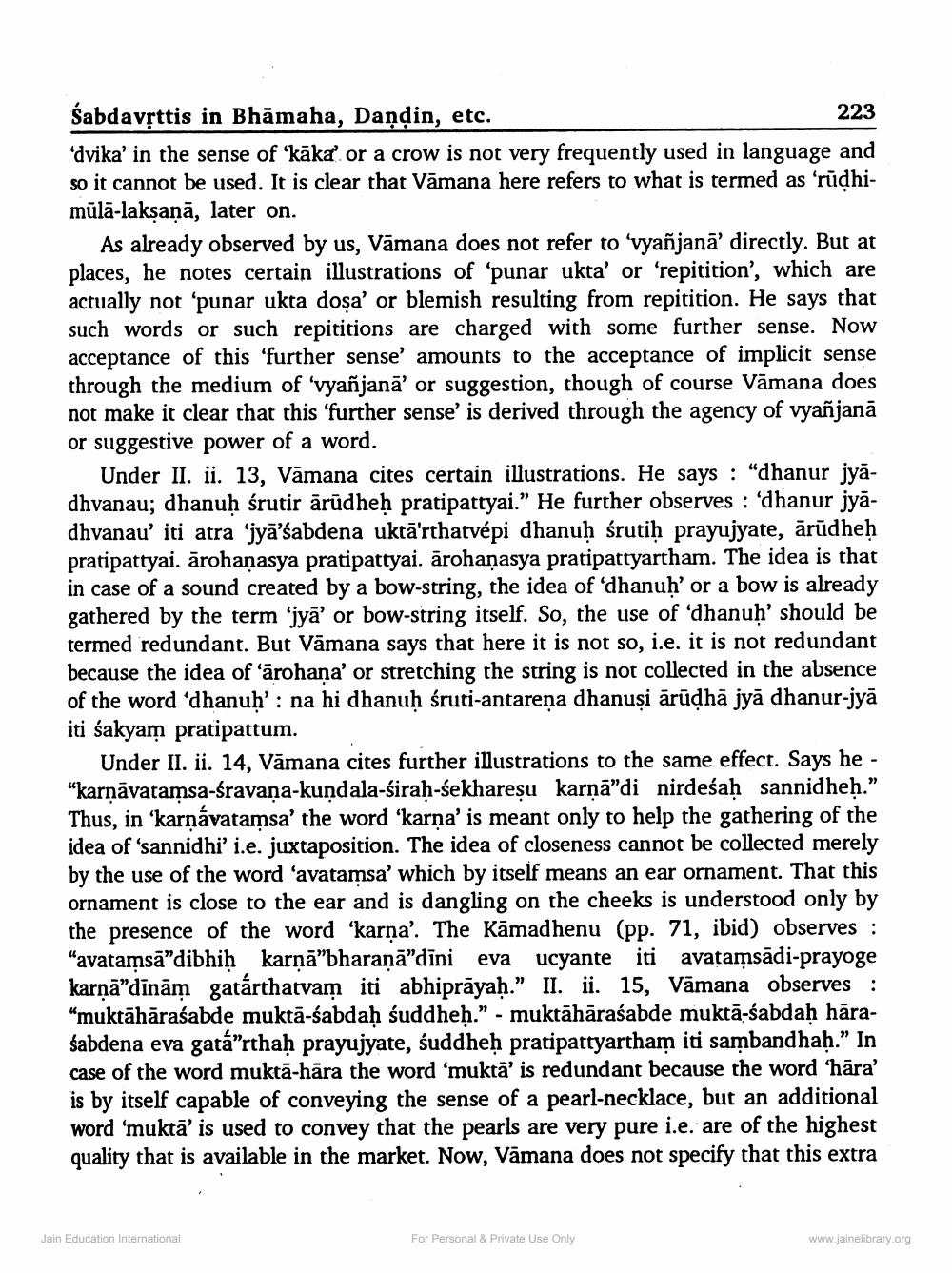________________
Sabdavrttis in Bhāmaha, Dandin, etc.
223 dvika' in the sense of ‘kāka' or a crow is not very frequently used in language and so it cannot be used. It is clear that Vamana here refers to what is termed as 'rūdhimūlā-lakṣaṇā, later on.
As already observed by us, Vāmana does not refer to 'vyañjana' directly. But at places, he notes certain illustrations of 'punar ukta' or 'repitition', which are actually not 'punar ukta dosa' or blemish resulting from repitition. He says that such words or such repititions are charged with some further sense. Now acceptance of this 'further sense' amounts to the acceptance of implicit sense through the medium of 'vyañjanā' or suggestion, though of course Vamana does not make it clear that this 'further sense' is derived through the agency of vyañjanā or suggestive power of a word.
Under II. ii. 13, Vāmana cites certain illustrations. He says: "dhanur jyādhvanau; dhanuḥ śrutir ārūdheh pratipattyai.” He further observes : 'dhanur jyādhvanau' iti atra 'jyā’śabdena uktā'rthatvépi dhanuḥ śrutiḥ prayujyate, ārūdheh pratipattyai. ārohanasya pratipattyai. arohanasya pratipattyartham. The idea is that in case of a sound created by a bow-string, the idea of dhanuh' or a bow is already gathered by the term 'jyā' or bow-string itself. So, the use of dhanuh' should be termed redundant. But Vamana says that here it is not so, i.e. it is not redundant because the idea of arohana' or stretching the string is not collected in the absence of the word 'dhanuḥ' : na hi dhanuḥ śruti-antareņa dhanuși ārūdhā jyā dhanur-jyā iti śakyam pratipattum.
Under II. ii. 14, Vāmana cites further illustrations to the same effect. Says he - “karņāvatamsa-śravana-kundala-sirah-sekhareșu karņā”di nirdeśaḥ sannidheḥ.” Thus, in 'karņávatamsa' the word 'karna' is meant only to help the gathering of the idea of 'sannidhi' i.e. juxtaposition. The idea of closeness cannot be collected merely by the use of the word 'avatamsa' which by itself means an ear ornament. That this ornament is close to the ear and is dangling on the cheeks is understood only by the presence of the word 'karna'. The Kāmadhenu (pp. 71, ibid) observes : "avatamsā”dibhiḥ karņā”bharaṇā”dīnieva ucyante iti avatamsādi-prayoge karņā”dinām gatárthatvam iti abhiprāyaḥ.” II. ii. 15, Vāmana observes : "muktāhāraśabde muktā-sabdah suddheh." - muktāhāraśabde muktā-śabdah hārašabdena eva gatá”rthah prayujyate, suddheh pratipattyartham iti sambandhah." In case of the word muktā-hāra the word 'muktā' is redundant because the word 'hāra' is by itself capable of conveying the sense of a pearl-necklace, but an additional word 'muktā' is used to convey that the pearls are very pure i.e. are of the highest quality that is available in the market. Now, Vamana does not specify that this extra
Jain Education International
For Personal & Private Use Only
www.jainelibrary.org




